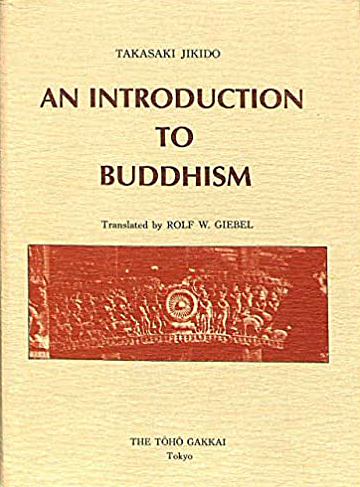No edit summary |
No edit summary |
||
| (6 intermediate revisions by the same user not shown) | |||
| Line 31: | Line 31: | ||
*{{i|III. Dharma: The Buddhist Conception of Truth|70}} | *{{i|III. Dharma: The Buddhist Conception of Truth|70}} | ||
**{{i|The Meanings of ''Dharma''|70}} | **{{i|The Meanings of ''Dharma''|70}} | ||
**{{i|The Basis of the Teaching: Dependent Co-arising and the Four Noble Truths|76}} | **{{i|The Basis of the Teaching: Dependent Co-arising and the Four Noble<br> Truths|76}} | ||
**{{i|Śākyamuni's: Philosophical Position: The Ten or Fourteen Unanswerables|85}} | **{{i|Śākyamuni's: Philosophical Position: The Ten or Fourteen Unanswerables|85}} | ||
**{{i|"Dharma-seals": The Watchwords of Buddhism|89}} | **{{i|"Dharma-seals": The Watchwords of Buddhism|89}} | ||
| Line 40: | Line 40: | ||
*{{i|IV. ''Sarva-dharmāh'': The Constituent Elements of Existence|107}} | *{{i|IV. ''Sarva-dharmāh'': The Constituent Elements of Existence|107}} | ||
**{{i|The Classification of the Constituent Elements of Existence in the Early Canon: The Five Aggregates, Twelve Sense-Fields, and Eighteen Realms|107}} | **{{i|The Classification of the Constituent Elements of Existence in the Early<br> Canon: The Five Aggregates, Twelve Sense-Fields, and Eighteen Realms|107}} | ||
**{{i|The Sarvāstivādin Classification of the Constituent Elements of Existence: The Five Categories and Seventy-five Elements|114}} | **{{i|The Sarvāstivādin Classification of the Constituent Elements of Existence:<br> The Five Categories and Seventy-five Elements|114}} | ||
**{{i|The Sarvāstivādin Theory of the Elements: The Elements Exist Eternally|120}} | **{{i|The Sarvāstivādin Theory of the Elements: The Elements Exist Eternally|120}} | ||
**{{i|The Mahāyānist Conception of the Elements: All is Empty|126}} | **{{i|The Mahāyānist Conception of the Elements: All is Empty|126}} | ||
| Line 61: | Line 61: | ||
**{{i|The Practices of the Bodhisattva: The Six Perfections|193}} | **{{i|The Practices of the Bodhisattva: The Six Perfections|193}} | ||
VII. Mind: The Agency of Practice | *{{i|VII. Mind: The Agency of Practice|198}} | ||
No-self and Subjective Agency | **{{i|No-self and Subjective Agency|198}} | ||
Mind (citta, manas, and | **{{i|Mind (''citta'', ''manas'', and ''vijñāna'')|200}} | ||
Mind-only and Cognition-only | **{{i|Mind-only and Cognition-only|205}} | ||
The | **{{i|The Innately Pure Mind and the Embryo of the Tathāgata|215}} | ||
Enlightenment | **{{i|Enlightenment and Salvation|223}} | ||
*{{i|VIII. The Ideal Practitioner|227}} | |||
The Introduction of Buddhism and Prince | **{{i|The Concept "Man"|227}} | ||
The Sects of the Nara Period | **{{i|Ordinary Man and Holy Man|228}} | ||
The Tendai and Shingon Sects | **{{i|The Stages of the Bodhisattva|233}} | ||
The Rise of the Pure Land Teachings | **{{i|"One Vehide" and "Three Vehicles"|240}} | ||
The Introduction of the Zen Sects | |||
The Nichiren and Ji Sects | *{{i|IX. The Precepts and the Organization of the Community|246}} | ||
Buddhism since the Muromachi Period | **{{i|The Meaning of ''Saṃgha''|246}} | ||
Sources | **{{i|The Organization of the Community|250}} | ||
Select Bibliography | **{{i|Community Regulations|255}} | ||
General Index | |||
Character | *{{i|X. The History of Buddhism|263}} | ||
The Author; the Translator | **{{i|1. Buddhism in India and the Surrounding Lands|264}} | ||
***{{i|The Basic Schism|264}} | |||
***{{i|The Mauryan Dynasty and Dissemination to Sri Lanka|266}} | |||
***{{i|The Kushan Dynasty and the Northern Tradition of Buddhism|267}} | |||
***{{i|The Characteristics of Schismatic Buddhism|268}} | |||
***{{i|The Birth of Mahāyāna Buddhism|269}} | |||
***{{i|The Mādhyamika and Yogācāra Schools|270}} | |||
***{{i|The Age of Esoteric Buddhism|272}} | |||
***{{i|Tibetan Buddhism|275}} | |||
***{{i|The Southern Tradition of Buddhism|277}} | |||
***{{i|The Revival of Buddhism in India|278}} | |||
**{{i|2. Chinese Buddhism|279}} | |||
***{{i|The Introduction of Buddhism|279}} | |||
***{{i|Buddhism Takes Root: The Period of the Northern and Southern<br> Dynasties|280}} | |||
***{{i|The Establishment of Chinese Buddhism: The Sui and T'ang<br> Dynasties|283}} | |||
***{{i|Subsequent Developments|290}} | |||
**{{i|3. Korean Buddhism|290}} | |||
**{{i|4. Japanese Buddhism|293}} | |||
***{{i|The Introduction of Buddhism and Prince Shōtoku|293}} | |||
***{{i|The Sects of the Nara Period|294}} | |||
***{{i|The Tendai and Shingon Sects|297}} | |||
***{{i|The Rise of the Pure Land Teachings|300}} | |||
***{{i|The Introduction of the Zen Sects|301}} | |||
***{{i|The Nichiren and Ji Sects|303}} | |||
***{{i|Buddhism since the Muromachi Period|305}} | |||
*{{i|Sources|309}} | |||
*{{i|Select Bibliography|315}} | |||
*{{i|General Index|325}} | |||
*{{i|Character Index|352}} | |||
*{{i|The Author; the Translator|375}} | |||
|AddRelatedTab=No | |AddRelatedTab=No | ||
|StopPersonRedirects=No | |||
}} | }} | ||
Latest revision as of 15:37, 7 August 2020
This book is based upon notes prepared by the author for general lectures on Buddhism which he has been giving to students at a number of universities in Tokyo since around 1960. The initial version of the present work first saw the light of day as part of a textbook for university students entitled Bukkyo ippan 仏教一般 (Buddhism in General) which was compiled in concert with professors specializing in Chinese and Japanese Buddhism and published by the Department of Buddhist Studies at Komazawa University in Tokyo. Then, at a later date, the author was approached by the Tokyo Daigaku Shuppankai (University of Tokyo Press) to write an introductory work on Buddhism for the edification of the general reading public. By permission of the Department of Buddhist Studies at Komazawa University, he accordingly extracted those sections of the above textbook which he had himself written ("Outline of Buddhism" and "Indian Buddhism"), to which he then made some additions and corrections and also appended a brief history of Buddhism covering not only India but also China and Japan. This was then published in 1983 under the title of Bukkyo nyümon 仏教入門 (An Introduction to Buddhism), of which the present work is an English translation. (Takasaki, preface to the English version, iii)
| Citation | Takasaki, Jikidō. An Introduction to Buddhism. Translated by Rolf W. Giebel. Tokyo: Tōhō Gakkai, 1987. |
|---|---|

